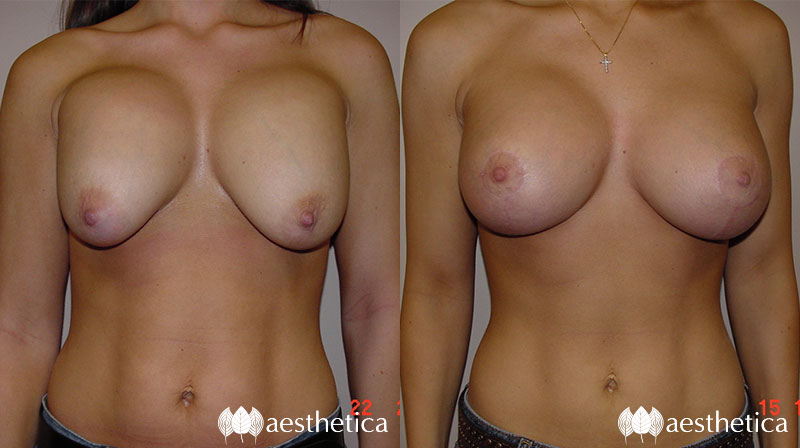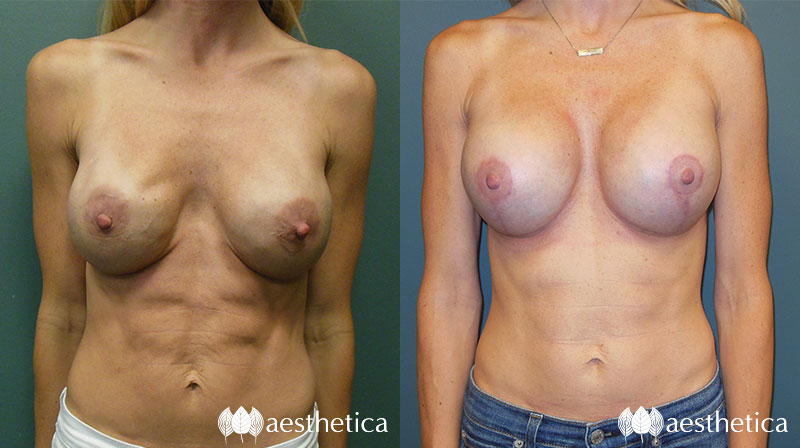It is advised for most patients to replace their breast implants every 10-15 years, however some patients opt in to replace them sooner. There are many reasons as to why patients may want, or in some cases, need breast implant revision. There are also many factors that make the appearance of breast implants look unnatural. Some of these factors include gaining or losing weight, pregnancy, breastfeeding, the breast augmentation procedure itself or the condition of the breast implant.
Common signs a breast implant revision may be needed:
Painful or uncomfortable breast implants
Persistent pain and discomfort are not normal for breast augmentation patients. There are a number of issues that cause painful or uncomfortable breast implants. Painful implants may be a sign of rupture, leakage, capsular contracture, seroma, damaged lymph nodes, poor implant placement or pinched nerves. Whatever the reason may be, it is best practice to schedule an appointment with an experienced plastic surgeon to address the issue at hand.
Implant ptosis or bottoming out
Implant ptosis occurs when a patient’s breast tissue and skin are not strong enough to support the weight of the implant. This leads to breast implants falling below the breast crease, or bottoming out, and the nipples to move upward as implants fall lower. Implant ptosis is commonly seen in patients with subglandular placed implants, heavy implants, post-surgery pregnancy or moderate to severe skin laxity. However, bottoming out can randomly occur with any patient. To read more about implant ptosis and the options Dr. Crofts offers, click here.
Breast implant rupture
Implant ruptures can be trauma induced, such as a car accident or other physical pressure, through the aging of the implant itself, weakening of implant shell, insertion of a needle or other medical instruments and many other circumstances.
Implant ruptures occur with all types of implants. Saline implants deflate and leak out quickly over the course of a few days and are noticeable. The saline solution is the same as IV solutions, which consists of water and salt, and is absorbed by the body.
On the other hand, when silicone or gummy implants rupture, it is much less noticeable. The ruptured gel is typically contained within the capsule, but may migrate outside of the capsule. Silicone and gummy implant ruptures typically must be diagnosed with an ultrasound or an MRI. Though not life-threatening, it can lead to infections and the development of irritated scar tissue since the gel is not absorbed by the body. It is recommended to replace a ruptured gel implant as soon as possible.
Capsular contractures
A capsule is a fibrous scar tissue that forms around any kind of implant or object that is foreign in the body. The formation of a capsule is the body’s natural response in the healing process; it is the body’s attempt to isolate the foreign object by creating a barrier around it. Capsules are usually soft and unnoticeable, however, in some rare cases, the tissue of the capsule hardens and becomes dense. This causes the capsule to squeeze and tighten around the implant. As a result, aesthetic problems arise- such as a change in the shape of breasts or the breasts rising higher on the chest- and in extreme cases, pain in the breasts.
Implant displacement
Implant displacement is a natural occurrence when implants shift to a different location on the chest wall. However, in some instances, the change in implant location is dramatic and unwanted.
- Bottoming Out: occurs when implants sit low on the chest, beneath the bottom of the breast. This is a result of breast tissue being stretched out over time or heavy implants.
- Lateral Displacement: occurs when breast implants can also settle away from the midchest. This is a result of breast pockets stretching over time.
- Symmastia: also known as “uniboob” or “bread-loafing”, is a rare occurrence caused by the skin and muscles between the breasts detaching. This problem can sometimes arise from over-dissecting the breast implant pocket near the breast bone.
Desire to change the size of breast implants
Some patients choose to have a breast implant revision simply because they are unhappy with the size of their implants. According to the American Society of Plastic Surgeons, 13% of patients preferred their breast size to have been larger post-augmentation and less than 2% of patients wished for a smaller size.
When searching for a surgeon to address your concern for a breast implant revision, it is important to choose an experienced Board Certified Plastic Surgeon, because implant revisions are not standard or routine according to ASPS. Breast implant revisions and re-augmentations can be difficult and a skilled Plastic Surgeon can maximize your results while minimizing complications. Dr. Crofts is a Board Certified Plastic Surgeon with over 20 years of experience. He has completed thousands of breast implant revisions and counting. To schedule a consultation with Dr. Crofts, call us at 801-785-8825 or fill out the contact form below.
Some breast implant revisions performed by Dr. Crofts. To view more before and after photos by Dr. Crofts, click here.







